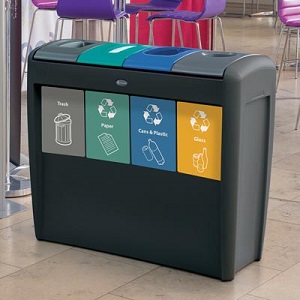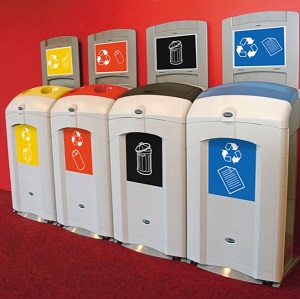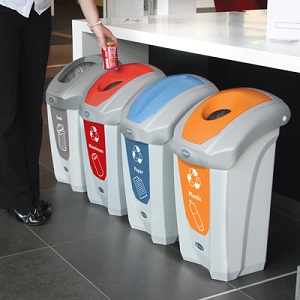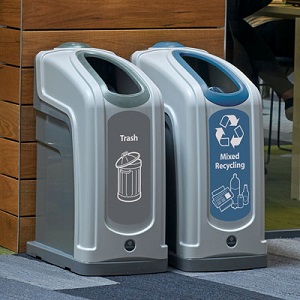When implementing a successful recycling program, it is important to carefully consider the placement of recycling options. This not only ensures effective waste collection but also promotes employee involvement in promoting sustainability in the workplace.

There are typically two methods for workplace recycling: common area and deskside. While their end goal is identical, each presents its own merits that may be more suitable for varying work environments.
What is Common Area Recycling?
The practice of placing recycling containers in shared or public spaces. These areas will typically contain other recycling containers and trash cans to ensure multiple people place waste in the correct place. These spaces can include cafeterias, break rooms, or hallways.
These containers are generally large and function as Recycling Stations, allowing for the collection of two or more types of waste in a single container.
Benefits of Common Area Recycling:

Centralized bins can be more cost-effective in terms of procurement and maintenance since fewer bins are needed compared to deskside bins for every employee.

With fewer containers, less space will be taken up compared to deskside recycling, making this a more suitable option for workplaces with limited room or open floor plans.

The act of gathering in communal areas to recycle has the potential to create a feeling of community and promote collaborative efforts toward a common objective.

Common area recycling containers can be easily monitored and managed by custodial staff or sustainability coordinators, ensuring that containers are regularly emptied and maintained.

Common area recycling provides an opportunity to educate and raise awareness among people who use those spaces. Educational signage and programs can help people understand the importance of recycling.
Nexus® Transform is the ultimate solution for common area recycling, offering unrivaled flexibility to allow customers to match the exact requirements of any recycling scheme. A selection of colors are available to color-code the aperture panels, as well as dedicated recycling decals, which will ensure the correct use of the chosen waste stream.
A solution that’s highly practical for office environments is the Nexus® 26G, a best-selling addition to many recycling programs. A slim design means they are ideal for siting together to create a unique recycling point.
From mixed recycling to paper, plastic, and food waste, Glasdon recycling containers can collect all types of waste commonly generated by a variety of workplaces.
What is Deskside Recycling?
The practice of placing recycling containers at or near individual desks or workstations. This system allows employees to dispose of their waste and recycle materials throughout the workday without leaving their desks to walk to a dedicated area for containers.
Deskside Recycling Containers are generally smaller than other Indoor Recycling Containers, so they can fit under or beside desks without taking up too much space.
Benefits of Deskside Recycling:

Deskside recycling is incredibly convenient for employees. With a recycling container within arm's reach, they can easily separate recyclables from other waste materials without having to leave their work area. This convenience can lead to higher participation rates.

Having a recycling container at one's desk encourages personal responsibility for waste disposal. Employees become more aware of their recycling habits and are more likely to actively participate in recycling efforts.

Deskside recycling can also serve as an educational tool. By keeping a recycling container easily visible at all times, employees are consistently reminded of the significance of their own waste responsibilities.

When employees have their own recycling containers, there's less chance of contamination since they are responsible for sorting their own recyclables from non-recyclables. This leads to a higher quality of recyclables collected, helps waste processing services, and ultimately means less waste in landfills.

Deskside recycling programs can be scaled up or down to accommodate changes in the size or layout of an office. They are adaptable and can grow with an organization's needs.
Measuring a height of just 626mm, the Nexus® 8G provides a convenient means of recycling that is perfectly suited for office use. Its slender construction allows for effortless placement underneath or alongside desks, making it an ideal office recycling solution.
The compact design of the Nexus® 13G allows for convenient placement in smaller spaces. Multiple bins can be positioned side-by-side near workstations to maximize space efficiency.
Choosing the Right Approach
The decision between common area and deskside recycling depends on your workplace's specific needs and priorities. However, many workplaces can gain success by combining both approaches for a comprehensive recycling program.
Here are some factors to consider when making your choice.

Evaluate the layout of your office space. Deskside recycling might be more practical in cubicles or small offices, while common area recycling could be more suitable for open-plan layouts.

Assess your budget for purchasing and maintaining recycling bins. Common area recycling may be more budget-friendly due to fewer bins needed.

Consider employee preferences and engagement levels. Some employees may prefer the convenience of deskside recycling, while others may appreciate the social aspect of common area recycling.

Evaluate your workplace's environmental goals. If you aim to achieve high recycling rates and reduce waste to landfills, deskside recycling may be the better choice.
In the quest for sustainability and responsible waste management, both deskside recycling and common area recycling have their advantages. The key is to choose the approach that aligns with your workplace's specific needs, layout, and budget while encouraging active participation from employees.
Whichever method you select, the ultimate goal is to reduce waste, divert recyclables from landfills, and contribute to a greener, more environmentally friendly workplace.
For more information on this subject, or if you have any questions about recycling solutions or assistance implementing a recycling program, please Contact Us Today!








